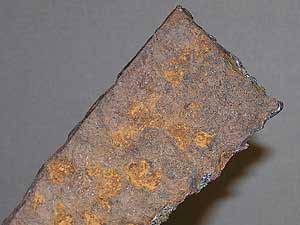|
Photos
More from MPR
Resources
|
Duluth, Minn. — Divers discovered the problem two years ago.
Half inch thick steel forms the sides of shipping docks and harbor walls. The steel plates keep the dirt in place and out of the harbor and shipping channels.
But there's a corrosion eating pits into underwater steel - basically holes in steel, that in many places is not very old. Steel plates that should last 50 years are showing damage in 10. The plates are rotting away at a pace that may result in failure decades early.
Duluth Seaway Facilities Director Jim Sharrow says Duluth's problem is unique among Great Lakes ports. And he says there's little sign of the rust just a few miles upstream in the St. Louis River.
"One of the things that we will be trying to do is to map, carefully, the extent of that coverage," Sharrow says. "Is it really as severe in all areas of the harbor? At the Oliver bridge, which is several miles above the navigation channel, we're not seeing this corrosion. We don't know if it has anything to do with shipping or just the other activities of the population around the harbor, or some other thing."
And, Sharrow says, the problem is clearly confined to the inner harbor.
"The corrosion is evident on the inside of the Duluth piers, right out to the lake, but not on the outside of the pier structure, where lake water is in contact with the steel," says Sharrow.
It's a costly problem. The steel plates are now being replaced at one grain elevator's dock. Sharrow says the rust is evident on the steel that lines the Superior entry, where ships follow the river channel in and out of the harbor.
"Part of the Superior entry is being replaced by the Corps of Engineers, because of the excessive corrosion," Sharrow says. "Both of those projects are giving us some corroded steel that can be reviewed and analyzed during the study."
Last summer, the Minnesota Legislature approved $100,000 to help study the corrosion. In November, Congress passed a funding bill with another $300,000. Sharrow says it's enough for a good start to figure out what's behind the rust.
"To study the water chemistry, and the condition of the steel pilings of the various docks, as well as the on going corrosion process," Sharrow says. "We also will be studying the rate of corrosion and various possible methods of protecting the steel."
Dave Bowman is a Project Manager with the U.S. Army Corps of Engineers in Detroit. He's seen the list of possibilities drawn up in a Duluth summit last year. There are theories about electrical currents or micro-organisms that can encourage premature rust. Bowman says he's not leaning toward a particular cause, but he puts some likely-hood in water quality.
"Main things seem to be the water chemistry; water temperature; or dissolved oxygen content - all those kind of water quality parameters," Bowman says. "So those are something that we can fairly easily look at. You know people have monitored that in the harbor for many years. And, those will be the first things that we look at."
The Corps of Engineers will lead the study. Bowman says the Corps also has a lot at stake in the results.
"The one figure that I saw was over half of the steel sheet pile in the harbor was corps' structures." Bowman says. "So, yeah, we are potentially on the line for tens of millions of dollars."
Meetings have begun to figure out the scope of a study. Officials think they may have some answers within two years.






